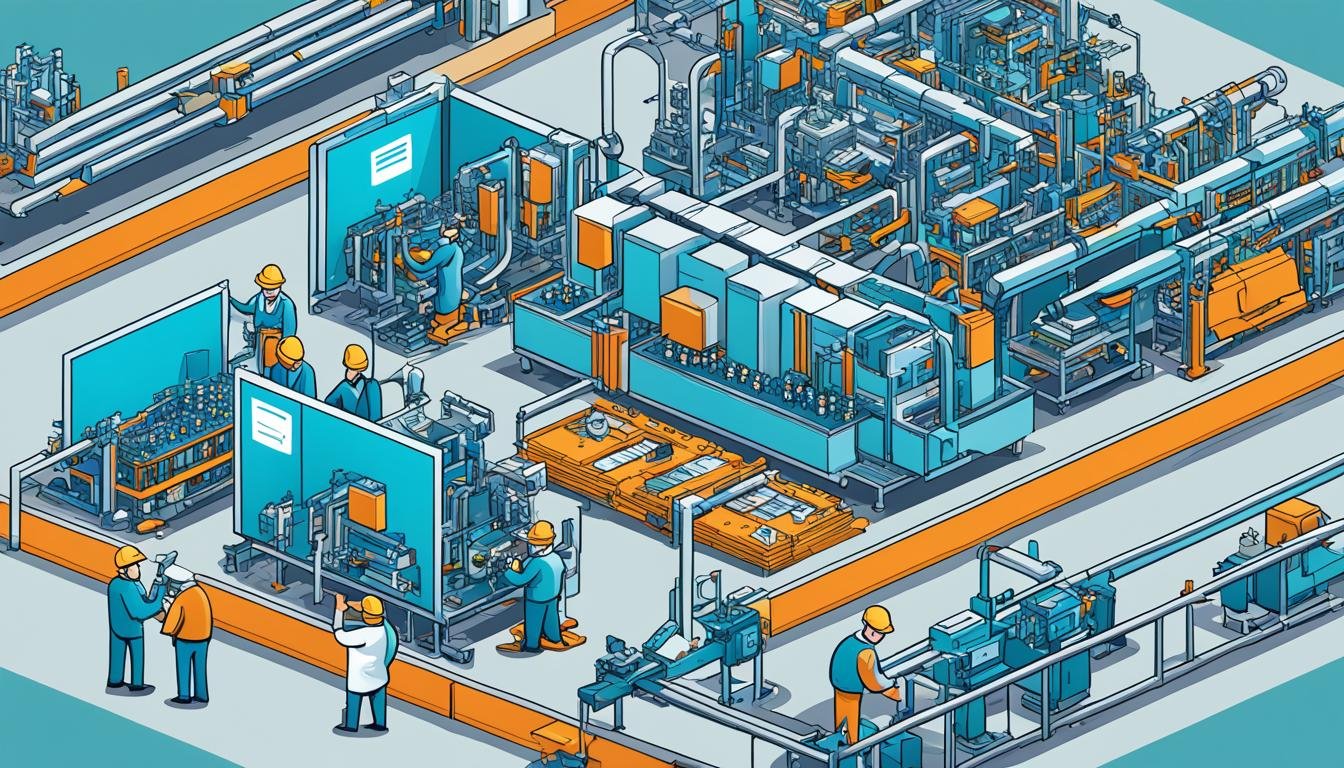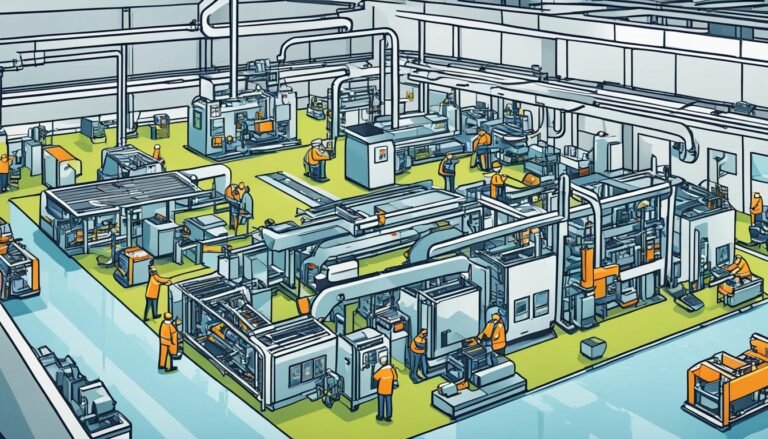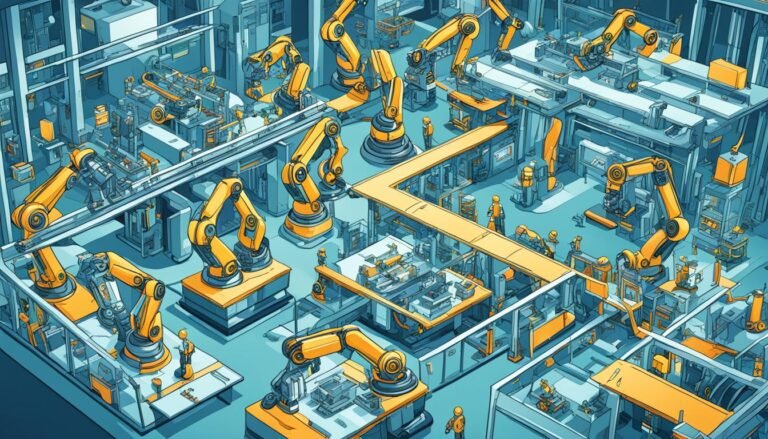Data-Driven Decision Making in Manufacturing
Did you know that only 31% of manufacturing companies are truly data-driven? This number has dropped from 37% two years ago. This shows a big change needed in the industry: using data to make decisions to stay ahead. Companies are spending $907 billion (5% of revenues) to improve connectivity. This shows how big the impact of using data is.
Data-driven manufacturing helps companies cut costs and work better by using data from many sources. This includes data from the shop floor, operators, and the supply chain.
This new way of making decisions uses data to find important insights. It helps companies make plans based on facts, not just guesses. This way, goals and plans are clear and free from personal opinions. Companies at different levels of using data find big benefits as they keep improving.
Using data also means using new technologies like artificial intelligence and machine learning. This is key for making production better and using AI in manufacturing. It helps make smarter decisions and saves a lot of money.
Key Takeaways
- Data-driven decision making in manufacturing aligns business strategies with concrete evidence, minimizing biases.
- Different stages of data maturity impact an organization’s ability to unlock the full value of data for decision making.
- Advancing to a data-mature level allows for justifiable, data-based decisions.
- Integrating AI and machine learning enhances predictive maintenance and overall efficiency in manufacturing.
- Investments in connectivity and data-driven practices can significantly reduce costs and improve operational efficiencies.
Introduction to Data-Driven Decision Making
Data-driven decision making is changing the game in manufacturing. It helps businesses make better choices by using lots of data. By looking at patterns in data, companies can make smart moves. This new way of making decisions is a big change from guessing.
What is Data-Driven Decision Making?
Data-driven decision making uses data to spot patterns and make strategic choices. It helps improve how things are made, manage supplies, and keep track of stock. With business intelligence tools, companies can look at all kinds of data. This helps them make decisions that are more accurate.
Importance of Data in Manufacturing
Data is a game-changer in making things. Using big data, companies can work better and save money. Things like profit margins, return on investment, and how much they produce are better with data.
Studies show that using data makes decisions better. A PwC survey found that companies that use data a lot make decisions three times better. Using tools for real-time data helps track how things are going and find ways to get better.
| Metric | Importance |
|---|---|
| Gross Profit Margin | Measures financial health by subtracting the cost of goods sold from net sales. |
| Return on Investment (ROI) | Assesses the value of investments in projects or technological upgrades. |
| Productivity | Calculates production efficiency by dividing output by input. |
| Total Number of Customers | Tracks customer base growth and market potential. |
| Recurring Revenue | Indicates stability and growth potential, especially for subscription-based models. |
Benefits of Manufacturing Analytics
Manufacturing Analytics brings many benefits to production processes. It uses real-time data to improve production lines. This ensures they work better and have less downtime.
For example, real-time data helps make quick changes during production. This leads to Process Optimization and better product quality.
Big Data Manufacturing helps improve supply chain management. It looks at data on demand, inventory, and suppliers. This helps companies make smart decisions, leading to faster deliveries and lower costs.
Real-time tracking of shipments and dynamic routing also make distribution better.
In warehouses, Manufacturing Analytics is a big help. It predicts demand and keeps inventory accurate. This makes sure warehouses run smoothly and uses resources well.
It also helps avoid overstocking and cuts down on waste. This is good for the environment.
“Big Data enables businesses to swiftly adapt to market fluctuations by analyzing various factors, ensuring a strategic advantage in dynamic industries.”
Manufacturing Analytics also lets companies make products just for customers. By looking at consumer data, they can make products that people really want. This makes customers happier and more loyal.
This kind of customization meets market needs and builds a strong bond with customers. It helps businesses grow over time.
But, there are challenges in using big data, like data silos and old IT systems. To overcome these, companies need a good plan. This includes setting clear goals, creating a central data hub, and hiring skilled people.
The following table outlines key benefits associated with the integration of Manufacturing Analytics:
| Benefit | Description |
|---|---|
| Efficient Process Optimization | Real-time adjustments enhance production quality and reduce waste |
| Supply Chain Management | Analyzing demand, inventory, and supplier data to streamline operations |
| Warehouse Efficiency | Predicting demand and optimizing inventory accuracy |
| Customized Products | Tailoring production to meet individual customer preferences |
| Market Adaptability | Swiftly responding to market shifts through data insights |
Role of Industrial Data Science
Industrial Data Science is changing how we make things by making smarter choices with data. It uses advanced analytics to turn big data into insights. This helps manufacturers make better decisions, work more efficiently, and boost productivity.
Data Collection Techniques
Getting the right data is key in Industrial Data Science for manufacturing. Many methods are used to collect important info. This includes sensor data for keeping machines running smoothly, machine data to check efficiency, and inventory data to manage stock better.
- Sensor Data: Key for predicting when machines need maintenance and checking their performance in real-time.
- Machine Data: Gives insights on how machines work well and spots any problems or slow spots.
- Production Data: Makes operations run better and increases productivity by looking at how much is made and how fast.
- Quality Data: Reduces mistakes and makes customers happier by testing quality.
- Inventory Data: Helps manage stock better by suggesting the best times to restock, cutting down on costs.
- Maintenance Data: Helps plan maintenance by looking at how often equipment needs fixing and cuts down on downtime.
- Process Data: Finds ways to make making things better or automate some steps by looking at process data.
- Supply Chain Data: Makes delivery routes better, cuts down on shipping costs, and keeps materials coming in on time.
- Customer Feedback: Helps predict what customers want and improve products by looking at what customers like.
Transforming Data into Insights
After collecting data, it’s analyzed to find insights that help improve businesses. Industrial Data Science uses advanced tools and skills to make sense of complex data. This includes:
- Data Understanding and Framing: Figuring out the business problem and setting it in a data context.
- Data Collection: Getting the right data from different places.
- Data Analysis: Using AI in manufacturing to find important insights in the data.
- Result Communication: Showing the findings and what actions to take with data visualization.
Using AI in manufacturing and data visualization helps quickly and accurately analyze data. This leads to making decisions based on data.
| Data Type | Benefit |
|---|---|
| Sensor Data | Predictive maintenance and real-time machine performance assessments |
| Machine Data | Insights into efficiency and bottleneck identification |
| Production Data | Streamlined operations and productivity improvement |
| Quality Data | Reduction of defect rates and enhanced customer satisfaction |
| Inventory Data | Optimized restocking times and lowered carrying costs |
| Maintenance Data | Effective predictive maintenance schedules |
| Process Data | Enhanced efficiency and process automation |
| Supply Chain Data | Optimized routes and reliable material supply |
| Customer Feedback | Demand forecasting and product enhancements |
Smart Factory Solutions and IoT in Manufacturing
The move to industry 4.0 has introduced Smart Factory Solutions. This marks a new era of automation and smarter communication between systems. IoT plays a big part in these changes, making operations more efficient and improving teamwork.
Integration of Smart Machines
Smart machines, with IoT tech, are crucial in this new era. They help different parts of the factory work together smoothly. For example, IoT in manufacturing could add $1.2 to $3.7 trillion to the economy by 2025, says McKinsey.
This growth comes from better automation, fewer mistakes, and smoother production. Smart machines make this possible.
“Digitization and automation have led to over a 65% reduction in manufacturing deviations, enhancing product quality and reducing defective product recalls,” states a report by McKinsey.
Real-time Data Monitoring
Real-time data monitoring is key to Smart Factory Solutions. It uses IoT to give live updates on what’s happening in the factory. This helps cut energy use, like Armal’s 40% drop in costs with IoT monitoring.
It also cuts down on maintenance costs and reduces equipment failures.
Studies by Deloitte show the power of predictive maintenance. It cuts equipment failures by 70% and maintenance costs by 25%. In 2019, manufacturing spent $200 billion on IoT, boosting efficiency a lot.
| Benefit | Statistic |
|---|---|
| Reduction in Equipment Breakdowns | 70% |
| Lower Maintenance Costs | 25% |
| Energy Cost Reduction by Real-time Monitoring | 40% |
| Economic Impact by 2025 | $1.2 to $3.7 Trillion |
As companies look for tech solutions, IoT in Manufacturing is leading the way. It’s making production more advanced, efficient, and green. The big changes in predictive maintenance and real-time monitoring show a move to smarter, quicker manufacturing.
Implementing Predictive Maintenance
Predictive maintenance is changing the game in manufacturing. It cuts downtime, lowers maintenance costs, and boosts efficiency. By using IoT and Big Data, it predicts machine problems before they happen. This means fixing issues early, avoiding production stops.
Switching to predictive maintenance cuts repair costs and makes machines last longer. Unplanned downtime costs up to $50 billion a year and can cut production by 20%. Predictive maintenance can save 5-10% on materials, reduce planning time by 10%-20%, and cut maintenance costs by 5%-10%.
| Benefits | Statistics |
|---|---|
| Reduction in Breakdowns | 70%-75% |
| Increase in ROI | 10X |
| Lower Maintenance Costs | 25%-30% |
| Reduced Downtime | 35%-45% |
IoT is key to predictive maintenance by collecting and monitoring data. Sensors in machines send data to AI for analysis. This predicts when equipment might fail. This way, maintenance is done only when needed, saving resources and keeping production smooth.
Strong data integration is also crucial. Systems like MES bring together data from different sources. This creates accurate models for predictive maintenance, improving operations.
Regular maintenance based on data can make machines last longer and make the workplace safer. It prevents accidents by fixing problems before they cause harm.
The first cost of predictive maintenance can be high, including IoT sensors, software, and skilled people. But the long-term benefits are worth it, giving a competitive edge. It makes production more efficient and reduces environmental impact by needing fewer replacements and repairs.
In conclusion, predictive maintenance is vital for today’s manufacturing. Using IoT and Big Data, companies can work more efficiently, keep production steady, and save money. This leads to success and sustainability in the future.
Data-Driven Decision Making in Manufacturing
Using data-driven strategies is changing the game in manufacturing. It helps companies make better decisions. This leads to better productivity, sustainability, and resilience.
Using ERP Systems
ERP Systems are key for making decisions based on data in manufacturing. They keep all data in one place. This makes sure everyone has the same information.
These systems bring together different business tasks like managing inventory and planning production. This helps companies keep track of data in real-time. It’s perfect for the Industry 4.0 era, which is growing fast.
Having one ERP system gets rid of data silos. This makes data easier to access and better quality. This is crucial for keeping manufacturing efficient.
Building a Data-Driven Culture
Creating a culture that values data over gut feelings takes effort. It needs strategic changes, teaching about data, and a supportive work environment. Encouraging data-driven decisions can really boost performance.
According to the Global Lighthouse Network Fourth Industrial Executive Survey, most companies focus on being more productive, sustainable, or resilient. Using data helps keep quality high and meet customer expectations. This builds loyalty and cuts down on returns.
Stages of Data Maturity
Manufacturing companies go through different stages of data maturity:
- Initial Stage: Companies don’t see the value in data and often make decisions based on gut feelings.
- Data Aware: Businesses start to see data’s importance but struggle to use it fully.
- Data Active: Companies use data sometimes for making decisions but face challenges in integrating it.
- Data Proficient: Companies use data regularly for making decisions, getting insights in real-time, and using predictive analytics.
- Data-Driven: At this stage, companies use data well for strategic decisions and optimizing production.
As companies move up, they get better at using data for forecasting, allocating resources, and improving performance. Being data mature isn’t just about technology. It’s also about seeing data as a key asset.
Using data at every step of manufacturing, from design to production, makes decisions more accurate. For example, using CAD tools and MBSE models makes projects clearer and reduces mistakes. This shortens development time and speeds up getting products to market.
In conclusion, mastering data-driven decision making in manufacturing is about using ERP Systems, building a strong data culture, and moving up in data maturity.
Conclusion
The move to data-driven decision making in manufacturing is a big change. It puts forward-thinking companies ahead of others. By using analytics, ERP systems, and a data-focused culture, companies can get a lot better at what they do.
A study from MIT Sloan School of Management shows that data-driven companies are 4% more productive and 6% more profitable. This proves how big the benefits of a data-driven approach can be.
Using smart factory solutions and IoT in manufacturing helps with real-time data tracking. This boosts both short-term and long-term results. For example, Industry 4.0 lets manufacturers turn lots of data into useful insights.
Companies like Google and Amazon show how data analysis can improve performance and find new opportunities. They use data to make better decisions and stay ahead.
Adding data to decision-making helps businesses stay flexible and make strategies for sustainable manufacturing. By seeing information as a key asset, companies can improve their operations and grow continuously. Data-driven strategies lead to better customer experiences, more accurate forecasts, and lower costs.
Adopting this new approach is crucial for manufacturers wanting to stay strong and successful in Industry 4.0.
Source Links
- Data-driven decision making in manufacturing – SYSPRO Blog
- Data-Driven Manufacturing: A Quick Guide – DataScienceCentral.com
- What is Data-Driven Manufacturing: The Definitive Guide
- BUS607 Study Guide: Unit 1: Introduction to Data-Driven Decision-Making | Saylor Academy
- Data-Driven Decision Making: A Step-by-Step Guide [2024] • Asana
- The Advantages of Data-Driven Decision-Making | HBS Online
- Data-Driven Decision-Making for Manufacturing: Harnessing Big Data for Competitive Advantage
- Council Post: Three Benefits Of Using Data To Drive Your Manufacturing Decisions
- Data Science in Manufacturing in 2024
- How Data Science Drives Business Decision-Making
- IoT in Manufacturing: Applications and Benefits of Smart Factories
- Smart manufacturing and the IoT are driving the Industry 4.0 revolution
- Unveiling the Secrets: How Predictive Maintenance is Revolutionizing Manufacturing
- A Comprehensive Guide to Predictive Maintenance in Manufacturing | 2023
- Pros of Implementing Predictive Maintenance in Manufacturing
- Embracing data-driven decision-making in manufacturing
- The Power of Data-Driven Decisions in Manufacturing
- The Key to Competitive Advantage
- The Importance of Data Driven Decision Making in Business
- Data-Driven Decision-Making: 6 Key Steps (+ Examples)







